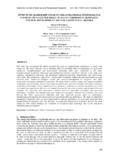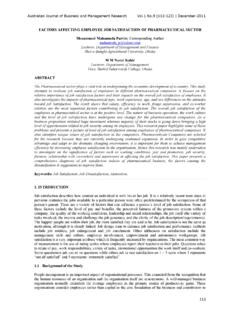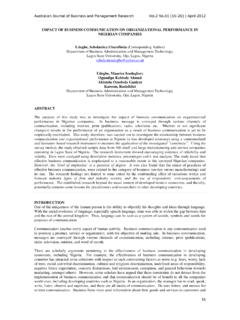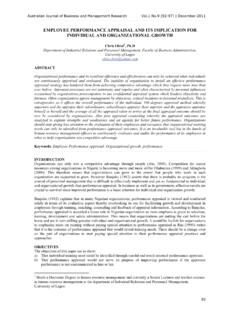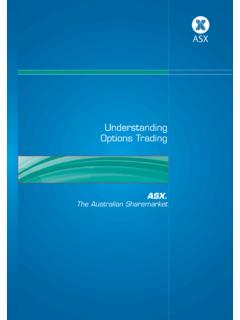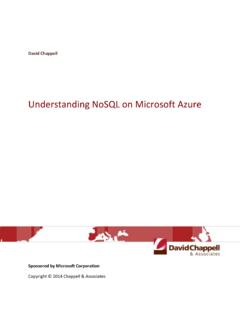Transcription of HISTORICAL AND IMPLIED VOLATILITY: AN …
1 Australian Journal of Business and Management Research [112-120] | October-2011. HISTORICAL AND IMPLIED volatility : AN INVESTIGATION INTO NSE NIFTY FUTURES. AND OPTIONS. R Parasuraman Director SDM Institute for Management development Site No. 1, Chamundi Hills Road Siddarth Nagar, Mysore Karnatak 570011, India Ph: 91-821-2429722, 2429161, 2420490. E-mail: Ramudu (Corresponding Author). Professor of Finance Alliance University School of Business Anekal-Chandapura Main Road Anekal, Bangalore Karnataka 562106. Ph:91-80-30938107. E-mail: ABSTRACT. The broad objective of the paper is to have an understanding of the movement of volatility over a fair period in respect of the market portfolio. Also, it enables an understanding on how divergent the IMPLIED volatility has been from this estimate.
2 It uses volatility Cone, volatility Smile and volatility Surface as the parameters. The study takes different rolling periods percentiles of volatility . Hoadley Options Calculator is used for calculation and analysis purpose. The study empirically proves that there is a clear reversion to the mean as indicated by the volatility cone. The study of volatility smiles in respect of NIFTY options throws up different patterns. The Garch ( ) model reveals that HISTORICAL volatility for the period from 2004 to 2004 and for the year 2009 were estimated. Interestingly, but not totally surprisingly, the average IMPLIED volatility of calls and puts on Nifty during the period January to March 2010 showed differences.
3 I. INTRODUCTION. The Black Scholes model requires us to input the volatility estimate for getting the value of an option. All the other inputs are easy to reckon, but volatility is a matter of estimation and expectation. Traders and investors estimate volatility based on their perspective and will get different model option prices. Ultimately the market option prices are decided by a weighted average of these estimates. The volatility that comes about from the price is the IMPLIED volatility and in most cases this is far removed from any legitimate estimate of the past volatility ( HISTORICAL volatility ). volatility has been a subject of great controversy over the years. Empirical research has not been able to show a ready pattern on the movement of volatility .
4 Research has concentrated on areas like the best possible estimates of HISTORICAL volatility , how the HISTORICAL volatility would tend to revert towards the mean, throw the IMPLIED volatility is related to HISTORICAL volatility , and the differences in all this when it comes to out of the money options. This paper seeks to look at the benchmark NIFTY stock during the period from 2004 to 2009 and analyze the HISTORICAL volatility patterns. Later, we try to look at what evidence we can draw from the HISTORICAL volatility estimates to use it for comparing with IMPLIED volatility . We also examine the phenomenon of volatility smiles and surfaces, and finally attempt a rough forecast based on the Garch ( ) model.
5 Specifically we look at the application of volatility smiles in respect of the index options during the period January to March 2010. On examination of the volatility smile on a daily basis we see changes happening with the smile changing its shape almost on a daily basis. What is more the IMPLIED volatility estimates are different for the puts and calls during the same period. 112. Australian Journal of Business and Management Research [112-120] | October-2011. Another analysis that has been done is on the HISTORICAL volatility over the period from 2004 to 2009 and to see the cone effect of reverting to the mean. The HISTORICAL volatility for various periods from 30 days on to 570. days has been carried out and the results are very interesting.
6 First we show the scope, objectives and the methodology used in the paper. We then look at select existing literature on the subject, including findings of other research. Later we discuss the model in detail. The last part consists of findings, conclusions and limitations of the study. II. SCOPE, OBJECTIVES AND METHODOLOGY. The paper aims to look at the NIFTY movements during the period 1st January, 2004 to 31st December, 2009. At the first stage, the HISTORICAL volatility for various time periods during 2004-2008 is analyzed and we ascertain whether the HISTORICAL volatility is demonstrating a tendency to revert to the mean. Next, we ascertain the IMPLIED volatility of NIFTY-based options during the period 1st January 2010 to 31st March, 2010.
7 The smile . effect is analyzed and the differences in findings as between the call IMPLIED volatility and the put IMPLIED volatility is looked into. We also look at the changes in IMPLIED volatility across various strike prices, given the same time frame. We have used the Hoadley Options Calculator for all purposes of calculation (Hoadley Trading and Investment Tools, the Hoadley Finance Add-in for Excel 2001-2010, Peter Hoadley). The study is exploratory in the sense that only the NIFTY index is considered and not all the stocks that form part of it. Also, a medium term has been reckoned for the purpose of calculating HISTORICAL volatility , the study on IMPLIED volatility has been restricted to the 3-month period subsequent to this.
8 The broad objective of the paper is to have an understanding of the movement of volatility over a fair period in respect of the market portfolio. Also, it enables an understanding on how divergent the IMPLIED volatility has been from this estimate. III. EMPIRICAL OBSERVATIONS ON volatility . Over the years a number of research papers have been brought out seeking to explain the movements of volatility and improving our understanding as to the factors that cause changes in volatility . While there is large number of studies available on the topic, we tried our level best to review some the most important and pertinent researches as under: Attempting to develop a model for volatility for the Indian stock market, Thiripal Raju and Rajesh (2010), found out that among all the models, the main equation was the most apt one to test the volatility of the stock markets.
9 Application of GARCH and Auto Correlation resulted in proving that measurement of volatility in the stock market is an important phenomenon from the view point of decision making by the investors. The study also demonstrated significant auto correlation in daily returns and a tendency to volatility clustering. In their model, Ozenbas et al (2009), found out that the volatility of a firm level component of stock price returns has increased relative to the market and industry components which resulted in a great puzzle. Using dynamic general equilibrium model, their research indicate whether the firms adjusted their capital structure if their stock price becomes more volatile and the effects.
10 The study found out that the larger stock volatility risk translated into higher financing cost inducing the firms to rely less on borrowed capital. Christner Ron (2009), made an attempt to study US stock market volatility as a result of 2008 fall. The research evaluated and analyzed weekly movements in some volatility variables for a period of eight months of 2008, four months pre and post 2008 fall respectively. Having compared the variables with the movement in NYSE, NASDAQ and S&P stock index the study found out that the relative volatility in the variables appears to be three times the volatility of indexes. The study also found out that the possible extreme situations and volatility are likely to re-occur in near future.
